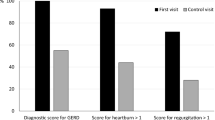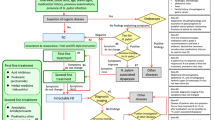Abstract
It is known that only a minority of patients with faecal incontinence report these symptoms to their physicians. Epidemiological estimates based on medical chart data, therefore, may contain a detection bias. To evaluate such bias in epidemiological data, we evaluated prospectively the presence of faecal incontinence in selected patient groups with a proven high incidence of such symptoms and compared it to the incidence in a group of healthy controls. If the patient acknowledged faecal incontinence in the questionnaire, the medical chart was checked to see if these symptoms had been noted during previous work-up; this was used to estimate the number of unregistered cases if the epidemiological estimate is based on medical chart data. The incidence of incontinence was significantly elevated in all patient groups as compared to the controls, but only up to 5% of patients with faecal incontinence, regardless of the underlying mechanism, had these incontinence symptoms noted in the medical charts. We conclude that for the estimation of the prevalence and incidence of faecal incontinence, data from medical charts contain a detection bias which systematically underestimates the real presence of faecal incontinence.
Résumé
On sait que seulement une minorité de patients atteints d'incontinence fécale déclarent ces symptomes à leur médecin. Les études épidémiologiques basées sur les dossiers médicaux, par conséquent, contiennent un biais de recrutement. Pour évaluer un tel biais dans les études épidémiologiques nous avons évalué prospectivement la présence d'une incontinence fécale dans des groupes de patients sélectionnés avec une incidence élevée prouvée de tels symptomes et comparée avec la même incidence dans un groupe de contrôles sain. Si le patient avouait une incontinence fécale dans le questionnaire, le dossier médical était étudié pour savoir si ces symptomes avaient été notés au cours de l'étude précédente; ceux ci étaient utilisés pour évaluer le nombre de cas non enregistrés si une estimation épidémiologique est basée sur les dossiers médicaux. L'incidence d'incontinences était significativement élevée chez tous les groupes de patients comparés aux contrôles, mais seulement 5% des patients avec une incontinence fécale, quelle qu'en soit le mécanisme, avaient ce syndrome d'incontinence noté dans leur dossier médical. Nous concluons que pour une estimation sur le prévalence et l'incidence d'une incontinence fécale les éléments du dossier médical contiennent un biais de détection qui sous-estime systématiquement la présence effective d'une incontinence fécale.
Similar content being viewed by others
References
Milne JS (1976) Prevalence of incontinence in the elderly age group. In: Willington EL (ed) Incontinence in the elderly. Academic Press, London, pp 9–31
Mandelstam DA (1984) Faecal incontinence. Social and economic factors. In: Henry MM, Swash M (eds) Coloproctology and the pelvic floor. Pathophysiology and management. Butterworth, London, pp 217–222
Drossman DA, Sandler RS, Broom CM, McKee DC (1986) Urgency and fecal soiling in people with bowel dysfunction. Dig Dis Sci 31:1221–1225
Leight RJ, Turnberg LA (1982) Faecal incontinence: the unvoiced symptom. The Lancet I:1349–1351
International classification of diseases (1977) Manual of the international statistical classification of diseases, injuries, and causes of death. WHO Publishers, Geneva
Hinds JP, Wald A (1989) Colonic and anorectal dysfunction associated with multiple sclerosis. Am J Gastroenterol 84:587–595
Feldman M, Schiller LR (1983) Disorders of gastrointestinal motility associated with diabetes mellitus. Ann Int Med 98:378–384
Whorwell PJ, McCallum M, Creed FH, Roberts CT (1986) Noncolonic features of irritable bowel syndrome. Gut 27:37–40
Author information
Authors and Affiliations
Additional information
Supported by a grant from the Deutsche Forschungsgemeinschaft (Er 142/1)
Rights and permissions
About this article
Cite this article
Enck, P., Bielefeldt, K., Rathmann, W. et al. Epidemiology of faecal incontinence in selected patient groups. Int J Colorect Dis 6, 143–146 (1991). https://doi.org/10.1007/BF00341234
Accepted:
Issue Date:
DOI: https://doi.org/10.1007/BF00341234




